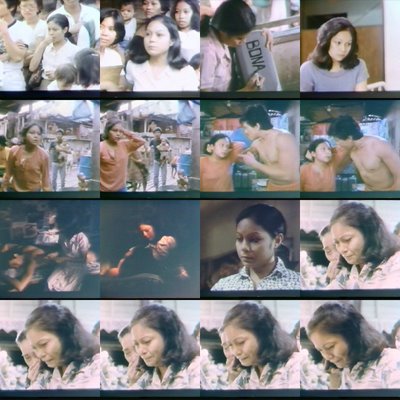
ESSENTIAL NORA AUNOR Film (Elliot Stein's Review Of Lino Brocka's BONA As Published In THE VILLAGE VOICE September 25, 1984)
Much of Bona’s strength resides in the simplicity of its narrative. Nearly all of the main action is set in Tondo, except for a brief but significant and startling opening sequence in which Bona appears in the middle of a hysterical crowd during the yearly procession of the Black Nazarene, the most violent and fanatical public Catholic ceremony in Manila. It suggests that the Church encourages her mad love of God to a mad love of Gardo.
Brocka’s melodrama is firmly planted in reality. Scenes of social texture are short, but are beautifully etched in the space around the only water pump in the neighborhood, which serves as a sort of a village square (a village ankle-deep in sewage), the men spend their nights getting drunk and singing Beatle’s songs while the women pray to the Virgin. One of the many miracles of this superbly directed movie is the way with rapid unsentimental strokes Brocka demarcates Bona’s assimilation in the slum, where her warmth and natural affability find a welcome they had been denied in the anxious middle-class background she has abandoned.
Brocka is one of the most physical of directors. His films are full of scenes of people touching nervously, tentatively touching one another and his rapport with actors is tremendous. Nora Aunor is a special case, she’s the Filipino’s favorite movie star, and more. Herself a slum child at 14, she won a singing contest and soon became a film personality, appearing in trivial, successful hit after hit; she now has her own weekly TV show. Aunor is a sociological phenomenon: the first dark-skinned superstar, idolized by the underclasses. Her fan’s devotion is unlimited. A score of them have come to live and work in her house as self-appointed servants. For many, she has the status of a saint. Her role in Bona in Brocka’s movie which she produced out of her own pocket in order to appear in a serious film is not unlike that of one of her own fan-servant-slaves.
Aunor’s co-star is no less than Phillip Salvador’s glistening body (who was Stanley Kowalski in Brocka’s Tagalog production of Streetcar) which Brocka makes us to see with Bona’s eyes in a dozen bed and bathtub scenes. The camera observes Salvador’s body with something of the meticulous awe with which Von Sternberg and his lenses ogled La Grande Marlene.
I’ve seen Bona three times and not yet had my fill of it, I don’t think a better movie has premiered in the city so far this year. More than a movie, it is also an act of civil disobedience.







0 comments:
Post a Comment